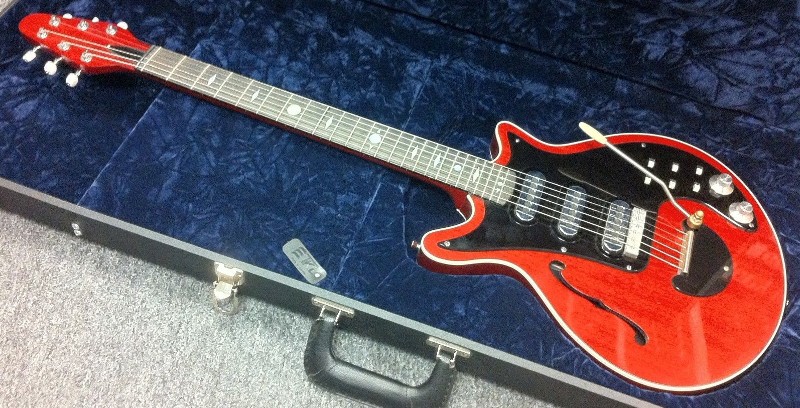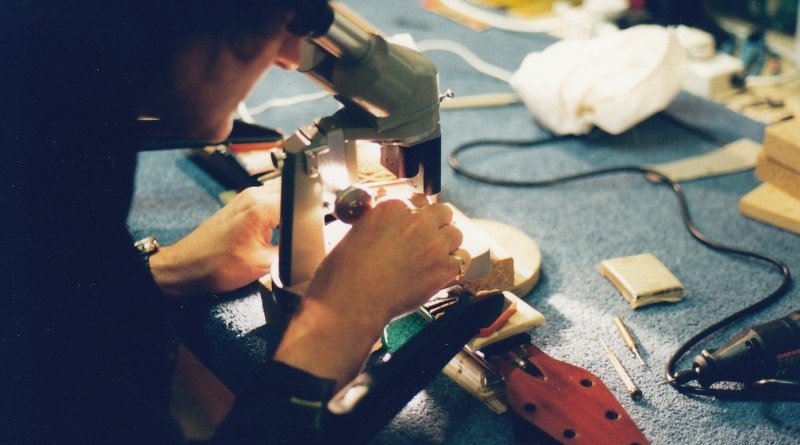Brian May’s Red Special has been a constant in his life since before Queen was even founded. He and his home made guitar have performed on thousands of stages over the years, and the fact that to this day it has still never required a refret should tell you everything you need to know about the attention to detail May put into this project.
In this KillerGuitarRigs Special, we’ll be taking a deep dive into this incredible guitar to look at some incredible facts about one of the world’s most treasured guitars.
Contents
- The Red Special was Born Because May Couldn’t Afford an Electric Guitar
- May’s Guitar was Made from Some Unusual Components
- The Red Special is not a Solid Body Electric Guitar
- Harold May’s Electronics Expertise Came in Handy
- The Red Special Has Needed Surprisingly Little Work to Keep it Functional
- Final Thoughts on Brian May’s Red Special
The Red Special was Born Because May Couldn’t Afford an Electric Guitar
Long before the Red Special was made, Brian May was a highly skilled guitar player, having first learned on an Egmond acoustic. By the time the 1960s rolled around, May wanted to advance to an electric guitar, but the prices were extremely prohibitive. Instrument catalogs of the day included Fenders and Gibsons, both of which were out of reach for young Brian May, and this meant only one thing – he had to get creative.
Brian May’s father, Harold, was an electrical engineer and an all around tinkerer, so despite the fact that he wasn’t able to buy an electric guitar for his son, he was still determined to get one into young Brian’s hands. The pair started a father-son project to build a guitar from scratch.
All told, the Red Special took the pair two years to complete from start to finish. It has seen a few changes in the years since. By 1965 it was ready, and ever since, it has been May’s number one guitar, only ever being replaced in live gigs in cases of broken strings or alternative tunings.
May’s Guitar was Made from Some Unusual Components
The build didn’t start until 1963, and as you might imagine, getting access to professional lutherie supplies wasn’t as straightforward as it is today. Owing to this fact (as well as the aforementioned cost restrictions), when Brian and Harold started building the Red Special, they needed to make do with the parts and materials they had to hand.
The neck, for example, was carved from a single piece of mahogany recovered from a Victorian era mantlepiece. The wood itself had at some point been so infested with woodworms, that the holes they left were big enough that Harold needed to plug them with match sticks.
Oak was used for the center block of the body, and just like the neck, this wood was repurposed, although this time from a table top. The wings of the body were actually made from blockboard, a type of plywood which gives many of the tonal benefits of solid wood, at a fraction of the cost.
Oak from a table and mahogany from a mantelpiece aren’t the most unusual parts, however. Remember, Brian and his dad used literally whatever they had to hand to make this guitar. For example, the binding is made from white plastic shelf edging – they knew it did a good job of protecting shelves from damage, and so knew it would work well on the guitar.
The tremolo system is one of the most unusual elements of the whole guitar. Instead of using tension springs mounted in the back of the instrument like the majority of trems, the Fender synchronized system for example, the Mays built the Red Special with valve compression springs they pulled from an old Norton motorcycle.
The tremolo arm itself might just be the most notorious component of all. It was originally made with a piece of steel from a bicycle saddlebag rack, but after discovering how uncomfortable this turned out to be, Brian raided his mother’s knitting supplies and “liberated” a long knitting needle, which was formed the tip of the whammy bar still seen on the guitar today.
The Red Special is not a Solid Body Electric Guitar

Believe it or not, Brian May’s Red Special is not a solid body instrument. May’s original intention for the guitar was for it to be a more traditional semi acoustic, and for it to feature an F hole on the bass side. Plans for the F hole fell through after May caught a glimpse of the finished exterior and couldn’t actually bring himself to cut through the gorgeous mahogany veneer on the guitar’s top.
Harold May’s Electronics Expertise Came in Handy
Given May’s father’s background in electrical engineering, setting up the pickups and the rest of the electronics was anything but straight forward. In fact, rather than just wiring in 3 pickups with a standard selector switch, like a Stratocaster, for example, the Red Special’s pickups were installed so that they could be run in parallel or in series, and so that they could be played in or out of phase.
In order to achieve easy adjustability, the guitar was fitted with 6 switches, with the top row designed to act as an “on/off” for each of the three pickups, while the bottom row inverted the polarity, which changed the phase.
The original design also featured a built-in distortion circuit modeled on a mid-60s Vox distortion FX unit, however it was short lived. Once Brian realized he actually preferred the tones of a cranked AC30 amp over the distortion circuit, it was quickly removed. Interestingly, the star shaped mother of pearl inlay you see on the guitar’s body today was placed to cover up the hole left by the removal of the switch for the distortion circuit.
The Red Special Has Needed Surprisingly Little Work to Keep it Functional

Unlike Willie Nelson’s Trigger, which has seen better days to put things lightly, the Red Special, which is actually the older of the 2 guitars, has barely needed any updates to keep it stage ready.
In 1988 it got is first major service. May asked legendary Australian luthier Greg Fryer, whom had built several authorized replicas of the Red Special, to perform restorative maintenance, using period correct components, and even the original “Rustin’s Plastic Coating” to refinish.
At the conclusion of Queen’s 2005 tour, the zero fret was replaced – which incidentally is the only fret that has ever been replaced on this guitar. This service was also used to modernize May’s guitar with the installation of a more contemporary ¼” jack socket.
The last known major service took place in 2016, with Andrew Guyton, of Guyton Guitars performing some finish repairs, and replacing one of the mother of pearl fret markers. The trem system also underwent maintenance at this time, where it was completely disassembled, lubed, and replaced.
Other than basic items like string replacement and cleaning, that is the extent of the maintenance history of the Red Special, which is extraordinary considering the number of shows it has played.
Final Thoughts on Brian May’s Red Special
The Red Special truly is an icon in the world of guitars. It’s instantly recognizable and attributable only to May himself. It has been heard on countless hits, and when you consider it was the first guitar he ever made, how it has held up over the decades is simply astonishing.


